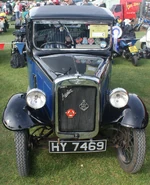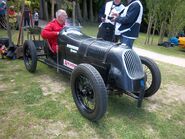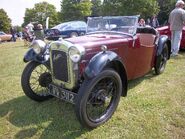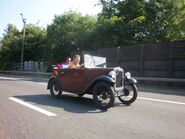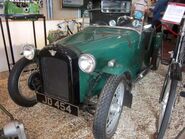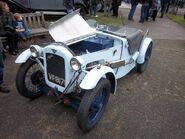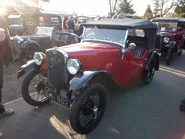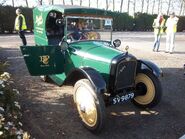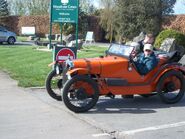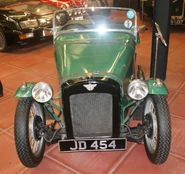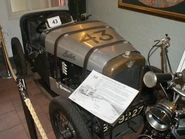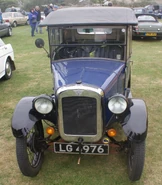
Austin 7 in 2 door saloon form
The Austin 7 was a car produced from 1922 through to 1939 in the United Kingdom by the Austin Motor Company. Nicknamed the "Baby Austin", it was one of the most popular cars ever produced for the British market, and sold well abroad. It wiped out most other British small cars and cyclecars of the early 1920s; its effect on the British market was similar to that of the Model T Ford in the USA. It was also licensed and copied by companies all over the world. The very first BMW car, the BMW Dixi, was a licensed Austin 7, as were the original American Austins. In France they were made and sold as Rosengarts. In Japan Nissan also used the 7 design as the basis for their original cars, although not under licence.
Many Austin 7s were rebuilt as "specials" after the Second World War, including the first Lotus, the Lotus Mk1, which was based on an Austin 7.
Such was the power of the Austin 7 name that the company re-used it for early versions of the A30 in 1951 and Mini in 1959.
History[]
Until the First World War Austin built mainly large cars, but in 1909 they sold a single-cylinder 7 hp built by Swift of Coventry called the Austin Seven. After this they returned to bigger cars, but Sir Herbert Austin felt a smaller car would be more popular, in spite of protestations from the company's board of directors who were concerned about the financial status of the company. Austin won them over by threatening to take the idea to their competitor Wolseley, and got permission to start on his design, in which he was assisted by a young draughtsman called Stanley Edge who worked from 1921 into 1922 at Austin's home, Lickey Grange. Austin put a large amount of his own money into the design and patented many of its innovations in his own name. In return for the investment he was paid a royalty of two guineas (£2, 2s), (£2.10) on every car sold.
Nearly 2,500 cars were made in the first year of production (1923), not as many as hoped, but within a few years the "big car in miniature" had wiped out the cyclecar industry and transformed the fortunes of the Austin Motor Co. By 1939 when production finally ended, 290,000 cars and vans had been made.
Chassis[]
The Austin 7 was considerably smaller than the Ford Model T. The wheelbase was only 6 ft 3 inches (1.905 m), and the track only 40 inches (1.016 m). Equally it was lighter - less than half the Ford's weight at 794 pounds (360 kg). The engine required for adequate performance was therefore equally reduced and the 747 cc sidevalve was quite capable with a modest 10 hp output.
The chassis took the form of an "A" with the engine mounted between the channel sections at the narrow front end. The rear suspension was by quarter elliptic springs cantilevered from the rear of the chassis while at the front the beam axle had a centrally mounted half elliptic transverse spring. Early cars did not have any shock absorbers. Brakes were on all wheels but at first the front brakes were operated by the handbrake and the rear by the footbrake, becoming fully coupled in 1930.
Circa 1933 the chassis was lengthened by 6" with a corresponding increase in the rear track. Steering is by worm and wheel mechanism.
Engine and transmission[]
The original 1922 four cylinder Austin Seven engine had a bore of 2.125" (54mm) and stroke of 3" (76mm), giving a capacity of 696cc and RAC rating of 7.2hp. From March 1923 the bore was increased to 2.2" (56mm) giving 747cc and 10.5hp. The side-valve engine was composed of an aluminium crankcase, cast iron cylinder block and cast iron cylinder head.
COMMENT - Cooling was by thermo-siphon, without a water pump, and the generator was driven from the timing gears. END COMMENT
COMMENT - the big end bearings were lubricated by jets from an oil gallery in the crankcase, the oil striking the crankshaft webs which were drilled accordingly. The front bearings was a ball radial/thrust, the rear may have been a roller, but I can't remember. Originally the shaft diameter was 1.25"; this was later increased to 1.3125". The three bearing engine used a white metal centre bearing. END COMMENT
The splash lubricated crankshaft (pressure fed on some sports models) at first ran in two bearings changing to three in 1936. An electric starter was fitted from November 1923. The early cars used magneto ignition, but this was changed to coil in 1928.
The 3-speed (4-speed from 1933) and reverse gearbox was integral with the engine, and had a variety of ratios depending on application. A four-speed gearbox was introduced in 1932 and in 1933 synchromesh was added to third and top ratios extending to second gear in 1934.
The back axle was of spiral bevel type with ratios between 4.4:1 and 5.6:1. A short torque tube ran forward from the differential housing to a bearing and bracket on the rear axle cross member.
Reliant used a derivative of the Austin Seven engine for their early three-wheelers, before developing an aluminium alloy engine (used as the replacement for the Austin Seven engine by the 750 Motor Club in their Formula 750 motor sport).
The Swallow[]
In 1927, William Lyons, co-founder of the Swallow Sidecar Company, saw the commercial potential of producing a rebodied Austin 7. Lyons commissioned the talented coachbuilder Cyril Holland to produce a distinctive open tourer: the Austin Seven Swallow.
With its bright two-tone colour scheme and a style befitting more expensive cars of the time, together with its low cost (£175), the Swallow proved popular and was followed in 1928 by a saloon version: the Austin Seven Swallow Saloon.
Approximately 3,500 bodies of various styles were produced up until 1932, when Lyons started making complete cars under the SS brand.
Such was the demand for the Austin Seven Swallows that Lyons was forced to move in 1928 from Blackpool to new premises in Coventry. It was, in part, the success of the Swallows that laid the foundations of what was to become, by 1945, Jaguar Cars.
Licensed production[]
Versions of the Austin 7 were made under licence by American Austin from 1930, Dixi (later bought by BMW) in Germany from 1927 and Rosengart in France from 1928. In addition, chassis and running gear were exported to Japan and Australia to have locally made bodies attached.
Australian Bodied Austin Sevens[]

Austin 7 Tourer Tasmania, Australia
In an attempt to establish an Australian motor industry after World War I, the Australian Government imposed a tax on imported cars. However, an imported chassis attracted minimal tax, and as a result Australian coach-builders imported rolling chassis to which they fitted custom-built bodies.
The largest and best known of these companies was Holden's Motor Body Builders. Holden was already manufacturing bodies for other marques, and in the mid-1920s commenced importing Austin Seven rolling chassis and building Australian-bodied Austin Seven tourer and roadster models.
The first Australian coachbuilt Austin Seven sports model was built by New South Wales Motors in 1924, and was known as the Ace. The Wasp was built by the Melbourne Motor Body Company of 149 Little Lonsadale Street Melbourne in 1927 and William Green of Parramatta Road, Petersham Sydney in 1929. The Comet was another Australian-bodied sports model, built by Bill Conoulty of Sydney between 1933 and 1934.
The Meteor sports model was produced by several coach-builders from 1928–1931, with James Flood of St Kilda Road Melbourne, Jack Lonzar of Adelaide and A Robinson & Co of 181 Castlereagh Street Sydney, producing limited numbers with variations on the design.
Trivia[]
In 2007, during an episode of Top Gear, Jeremy Clarkson and James May studied a number of early car designs (including the Ford Model T and the De Dion-Bouton Model Q and concluded that the Austin Seven was the first mass-market car to be fitted with a "conventional" control layout, as found on modern cars (although the earliest car they found to use this layout was a Cadillac). Motoring enthusiast and Pink Floyd drummer Nick Mason has claimed a 'Chummy' as his first car, in his book 'Inside Out'.

